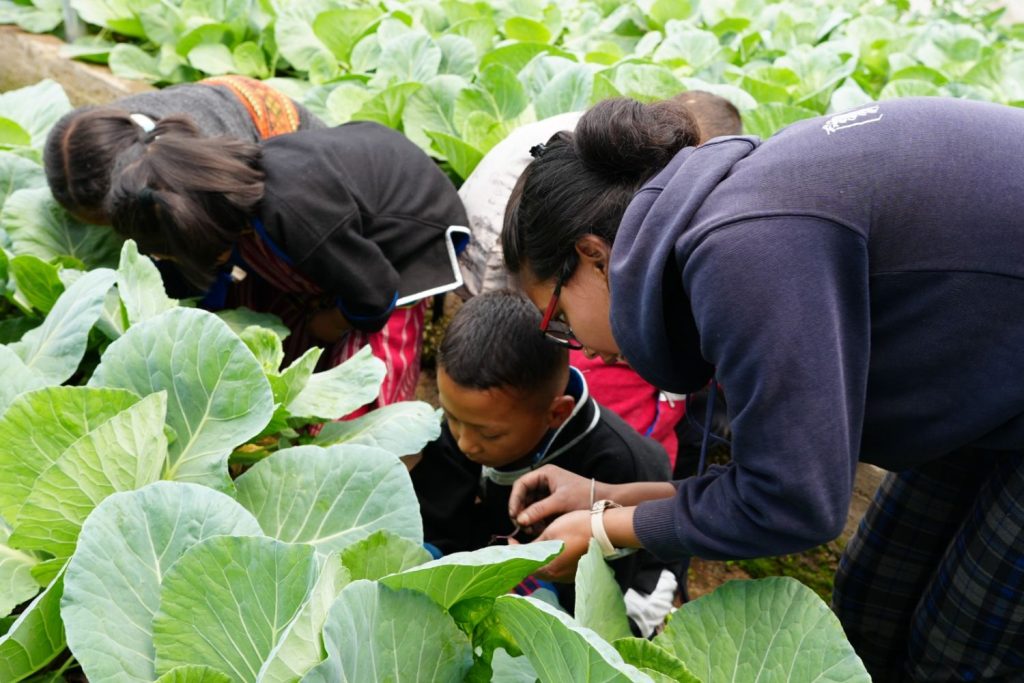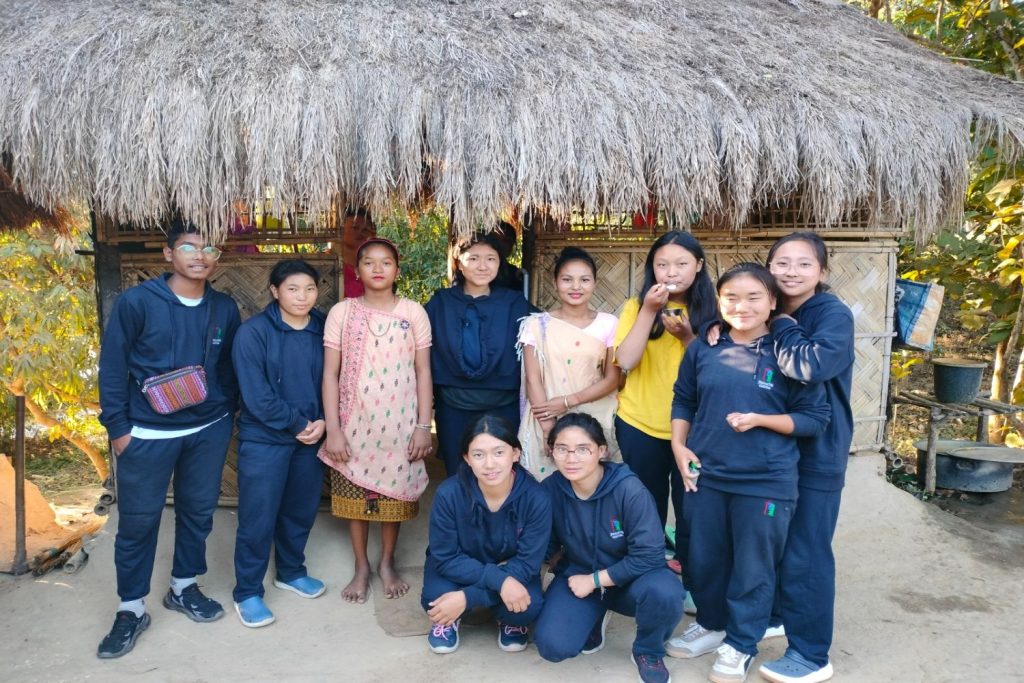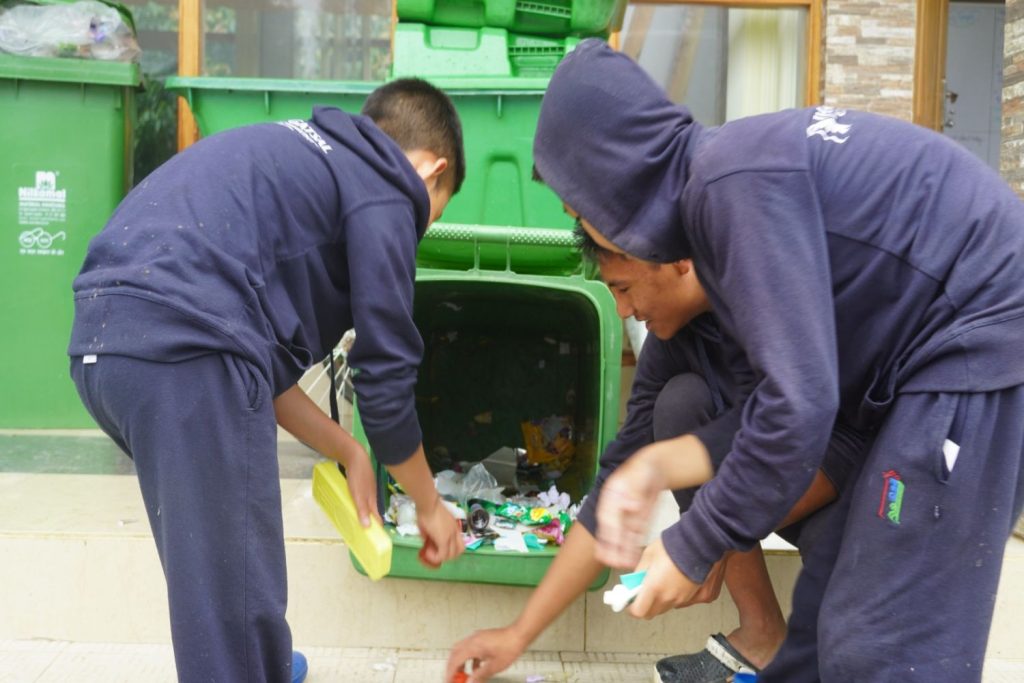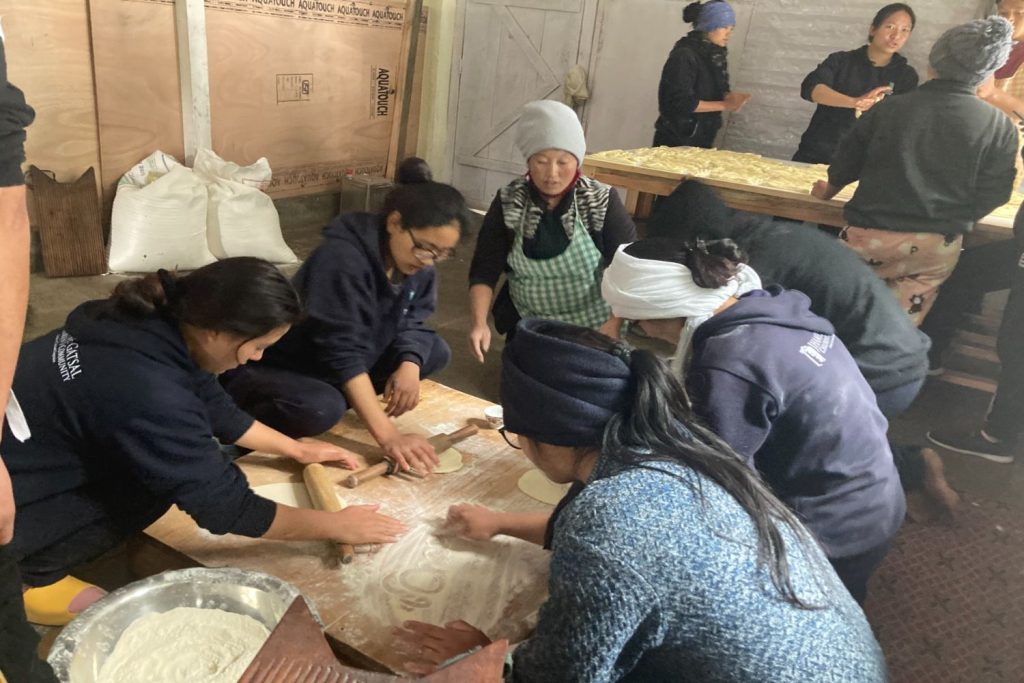Modeling leadership styles – Through the lens of leaders?
In this piece we talk to people working in the field of school leadership to gain insights into various leadership styles

In this piece we talk to people working in the field of school leadership to gain insights into various leadership styles. Our panel of educators and education leaders comes from diverse backgrounds and contexts. They are all working towards a common goal: nurturing children. From Jhamtse Gatsal in Arunachal Pradesh to Sandeepani Academy for Excellence in Bengaluru and a Municipal Corporation of Delhi School partnering with Kshamtalaya, they represent different regions and approaches in Indian education. These educators and leaders share their experiences and insights on how they are shaping the future of their students. They discuss their leadership models. The discussion focuses on creating safe and inclusive environments and emphasizes the school cultures they cultivate to realize their values and vision.
Established in 2006, Jhamtse Gatsal Children’s Community is a loving home and learning environment for 107 orphaned, abandoned and vulnerable children ranging from toddlers through young adults. The children primarily belong to the local Monpa tribe. They come from diverse backgrounds of adversity. Jhamtse Gatsal, in the local language, means “garden of love and compassion.”
Kshamtalaya is a non-profit organization founded to support school children in disadvantaged settings so that they develop into socially and economically active young adults. They intervene to improve school enrolment, attendance, academic outcomes and life prospects for students in rural and marginalized settings. They want to actualize a rural India in which children successfully make a transition from compulsory school education to having happy and productive lives.
Saandeepani Academy for Excellence is a progressive school inspired by the philosophies of Rabindranath Tagore. It tries to create a fear-free and joyful learning environment, instil a love for learning, joy in creative expression, and nurture young minds to become life-long learners.
Rekha N: How do you see your role as a school leader? What have been your priorities as a school leader?
MCD school principal (Kshamtalaya’s partner school): I have a long history in this school, starting as a teacher, then as a school in charge, and now as the principal. To me, understanding each child’s background and context is key to their education. Teaching and learning must align with the child’s context, shaping every decision, including curricular choices. In our corporation school, most parents haven’t had an education. We don’t view our work here as a profession but as a responsibility to provide the best education to the children.
In my journey, instilling moral values and a strong foundational education have been top priorities. Many of our students come from challenging backgrounds, so we dedicate 5-10 minutes daily to discussing moral values. A robust foundation and value-based education have been our focal points. Our efforts have borne fruit, as alumni still cherish the values they imbibed here.

We continue to support our children even after they move on to middle school and beyond. Our goal is to prepare them for life. What brings us immense joy is the enduring connection our children maintain with us.
Divya (Sandeepani): Our primary focus is to create a safe and inclusive environment for our students. Safety, encompassing emotional, physical and mental well-being, is our utmost priority. We prioritize safety over rigid adherence to a set curriculum, acknowledging that each child’s unique needs must be met.
Vasudha (Jhamtse Gatsal): We are a community of people who live together with the similar intention of raising children mindfully, consistently and in many ways to bring them up as safe, healthy and happy adults. We see our community as a family, and we refer to it as the “garden of love and compassion.” Our responsibility is to nurture and provide guidance to the children who often come from difficult backgrounds.
Rekha N: How do your actions as a school leader ensure that the above priority areas are catered to?
MCD school principal (Kshamtalaya’s partner School): My role as a school leader encompasses diverse responsibilities. I collaborate with parents, support teachers in navigating challenges, and embark on new initiatives such as inclusive education for children with diverse learning needs. This initiative is particularly close to my heart. We have six children with special needs in our school. I have an accessible room where I can observe and ensure their safety. I personally engage with two of these children, offering morning hugs that fill me with joy.
Our school is embracing inclusive practices. We consult experts to provide necessary accommodations, ensuring emotional safety for these children. We also maintain a close connection with parents to assess the impact of the interventions.
Divya (Sandeepani): Our teachers undergo extensive training, including an orientation at the beginning of the academic year. This training emphasizes our teaching methodology, the “5A” approach: Aim, Activity, Analysis, Application and Assessment. We also teach our educators how to ensure students’ physical safety by always keeping them within the vicinity of an adult, even outside of regular school hours.
Emotional safety is equally important. We educate our teachers on how to communicate with students, both individually and in group settings. This training helps prevent bullying and fosters a supportive atmosphere. It’s essential that teachers create a trusting environment where children feel emotionally secure.Mental safety is another facet of our approach. We continually assess students’ understanding of concepts and provide additional support or re-teaching as needed. Regular reflections, debates and discussions on our policies ensure we adapt to evolving needs.
Moreover, classroom observations, led by coordinators, help us assess the effectiveness of our teaching methods. We provide constructive feedback, not just on academic progress but also on the language and communication used in the classroom, as the way teachers convey intentions can affect students’ perceptions.
Yogita (Sandeepani): In my role, I serve as a crucial link between the school’s teachers and external organizations, such as those that offer behavioral support for students on the autism spectrum. With over 40 students under our care, my responsibilities involve facilitating the flow of information and support.
When a teacher identifies a student struggling academically, they report it to me as the coordinator. My duty is to share this information with the academic team and external experts. These experts assess the situation and determine whether a diagnostic report is necessary. We also consider when and how to involve parents, always seeking their permission for further observations.
Once we have a comprehensive understanding of a student’s needs, we decide whether inclusion in specialized programs, such as therapy or remediation, is needed. My role is to ensure that this process runs smoothly and that we provide tailored support to each child, helping them thrive academically and personally.
Vasudha (Jhamtse Gatsal): In our community, teaching and learning are intertwined in a constant cycle. Teachers are not just providers of knowledge. We don’t see the children as empty vessels waiting to be filled. Instead, we view them as seeds with the potential to grow into healthy, thriving individuals. Just like an apple seed has everything it needs to become an apple tree, children have unique talents and abilities within them. Our role is to nurture and guide them.
While we do cover traditional subjects in our school, our education model goes beyond that. We aim to educate the heart, the mind and the body. This is because we believe that all these aspects define us as human beings. The mind guides our actions, the heart nurtures compassion and empathy, and the
body serves others and humanity.
Our culture is centered on service. This is what we instil in our children from a young age. We don’t see ourselves as leaders but as servants of the community. In our culture, service is a two-way street. This is unlike the Western concept, where the giver is on the top, and the receiver is at the bottom. We believe in serving each other and all of humanity.
Our approach to education involves holistic development. We start the day with meditation or prayer sessions to promote mindfulness. Throughout the day, children engage in various activities, both academic and practical. They learn about sustainability by growing their own food and practicing rainwater harvesting and blackwater recycling.
One remarkable aspect of our education is “SEE learning.” This involves focusing on social, emotional and ethical learning. We believe in building emotional equanimity from a young age. This prepares children for the conflicts they will inevitably face in life.
Rashmi (Jhamtse Gatsal): Interdependence is a core value in our community. Children are assigned duties on a rotating basis. They quickly learn that they must rely on each other. We avoid using the word “help” and instead emphasize “service.” This is done to ensure that everyone feels equal and interconnected. Furthermore, our community members, regardless of their roles, are considered teachers for life. We celebrate a “Staff Day,” because we believe that everyone on our campus has something valuable to teach and learn from each other. We create a learning space for everyone, not just students.
Vasudha (Jhamtse Gatsal): In every situation, we understand that we can be both givers and receivers. Learning how to receive with gratitude is as crucial as giving. We have seven core values that guide us: interdependence, equanimity, generosity, gratitude, love, compassion, and responsibility.
These values are woven into our daily lives in an organic and natural way, promoting personal growth and creating a harmonious community where learning and service go hand in hand.
Rekha N: What does leadership look like in your school?
MCD school principal (Kshamtalaya’s partner school): In our school, leadership is synonymous with shared vision and responsibility. Every member, including teachers, takes ownership of our vision. Shared responsibilities are integral to our approach. I use different strategies to encourage active participation. We have teachers managing additional responsibilities. I have organized WhatsApp groups to streamline communication.
I take a hands-on approach initially, guiding them through their responsibilities. Over time, I empower them to handle tasks independently, under my supervision. With 1,000 students and 30 teachers, our responsibilities are immense. We collectively tackle unforeseen situations, fostering an environment where no one doubts our ability to navigate challenges.
While I maintain discipline, I prioritize creating an atmosphere of love, care and connection. I have worked hard to establish a bond with the teachers, fostering emotional safety and trust. I strive to ensure that the rigid hierarchies of the past do not stifle openness and communication.
Quality education is our foremost goal. I encourage teachers to be role models for their students. Children keenly observe and learn from us. They mirror our mannerisms and behavior. Discipline is essential. However, I also aim to nurture an environment of love, care and connections.
I closely observe and understand each teacher. I try to identify those with potential and encourage initiative. For instance, a recent TLM exhibition saw enthusiastic participation even from previously reserved teachers. One new teacher who initially struggled, came to shine, displaying remarkable TLMs for children with diverse learning needs. Our goal is to empower teachers and make them realize their importance in shaping education.
Divya (Sandeepani): We have around 700 students. In our school, leadership takes on a unique structure due to our commitment to a flat hierarchy. The flat structure means we don’t have traditional grade-level coordinators. Our leadership begins with our founder. She serves as the managing trustee and founder of the school. She actively participates in decision-making across all aspects of our institution, from curriculum to co-curricular activities and even infrastructure.
Following her, is our school’s director, who oversees all academic matters. Essentially, all coordinators and those at the next level of hierarchy report to her. Our school principal focuses on matters related to the Central Board of Secondary Education (CBSE), Board-related issues, and parent communication. Additionally, we have coordinators responsible for various grade levels, including preschool, grades 1-2, 3-5, 6-7, and 8-10. This organizational structure helps us cater to students at different developmental stages.

Regarding decision-making, until grade five, academic coordinators play a significant role in shaping our educational approach. We also have subject coordinators, each with expertise in specific subjects, contributing to our comprehensive curriculum. This setup ensures that academic decisions align with our pedagogical goals.
In summary, our leadership structure promotes collaboration among staff to ensure a safe and joyful learning environment for our students. We prioritize safety, both emotional and physical, and employ a holistic teaching approach that emphasizes individual growth and development. This commitment to our students’ well-being drives our school’s success.
Vasudha (Jhamtse Gatsal): In terms of leadership style, we have a decentralized and egalitarian system. Each department has its own leaders whom we empower. While we offer support and direction as needed, the real work happens within these independently functioning units. We believe in enabling individuals and teams to find solutions to challenges within their own domains. Whether it’s the older children supporting the younger ones, or the various departments like education, kitchen and so on, each unit contributes to providing layers of nurture and guidance.
If there’s a conflict or a difficult situation among the children or the teachers, we encourage them to solve it among themselves rather than coming to us. It is very important that everybody feels equipped and has ownership towards the place and towards the situation. It is not the leadership’s job to always provide top-down guidance or solutions. Often, our founder conducts workshops with us to help us understand our vision. Our hope is that one day the world will live in one unified community based on love and compassion. Compassion is the foundation that carries through all our actions.
Rekha N: Could you give some examples or instances demonstrating the leadership model in your school?
Jyoti (Kshamtalaya): We would like to highlight a community initiative here. During the Covid-19 pandemic, our approach to engaging with communities underwent significant changes. Initially, when children ceased attending school, it became evident that reaching them was a formidable challenge. After consulting with our teachers, it became clear that many students lacked access to the internet or even basic phones. To address this issue, we initiated home visits. However, we soon realized that this approach was unsustainable and we couldn’t reach all the children in need.
Recognizing the need for a more comprehensive strategy, we introduced the “Family Champions” program. The idea was to engage community members as volunteers who could effectively connect with all the children in their respective communities. We identified proactive parents who were willing to participate and provided them with training. Each of these parents then shared their knowledge and skills with other parents, each reaching out to at least 10-15 families within the same community.
To further bolster the program and address the identified need for increased support, we initiated training sessions for parents on foundational literacy and numeracy (FLN). These trained parents established learning centers within their homes, where they engaged with groups of 25 children to enhance their FLN skills. This concerted effort led to the development of 65 family champions who, in turn, reached an impressive 1,600 children in the community.

In addition to these efforts, the family champions organized meetings with other parents to discuss their children’s progress and offer guidance on child safety. Currently, we are collaborating with an additional 50 family champions to expand our reach and impact.
The school leader of our partner school played a pivotal role in the success of the Family Champions Program. She provided essential support by conducting training sessions for the family champions, attending meetings, engaging with parents, and offering motivation. Moreover, our school leader guided us to reflect on our program approaches and initiatives, continuously seeking ways to strengthen the program.
Our school leader also facilitated the integration of family champions into school events. This ensured their active participation and contribution. We organized a learning festival at our school where parents taught for a week, sharing their skills and knowledge. Our school leader observed these sessions, provided constructive feedback to the parents, and publicly recognized and appreciated their work.
Furthermore, our school leader has been proactive in ensuring that our teachers actively engage with parents and foster strong partnerships. She has even recommended certain parents to us. We have subsequently recognized them as family champions. These efforts highlight how our school leader has been instrumental in promoting effective community participation in our children’s learning journeys.
Divya (Sandeepani): The policies of the school are from the management, but in consultation with the coordinators. When we are making a policy, for example, the idea may start from the management, the director, and the founder of the school. And it may be discussed with the coordinators. When the coordinators are involved, everything should be data-driven. The actual data is available with the teachers, the class teachers, and the subject teachers.
So, we do take it to the SLMs, which stands for “Sharing Learning Meetings.” The SLMs create a place where we discuss our challenges, our successes, our failures, everything. As the name suggests, it’s about sharing learning. In these meetings, we find out the reality. Then we take it up to the school’s director and founder. The process is formulated, and it may change according to the requirements of the team.
Yogita (Sandeepani): We have “Drop Everything and Read (DEAR)” in our timetable, where children read for pleasure. There is no stress of academics during this time. The modification in the timetable to create this space is provided by the school management. When it comes to teachers, they have the flexibility to design how the DEAR classes are conducted. They can read to students, students can read to each other, or they can sit in the library and read. Teachers can devise worksheets or strategies based on the diverse needs of their students. The autonomy allows teachers to adapt and innovate as needed.
Divya (Sandeepani): Teachers also have the autonomy to identify and address individual student needs, whether it’s providing extra support or challenging advanced learners. The decision-making process is collaborative and transparent. We constantly assess our students through regular formative assessments. The teachers work together to design interdisciplinary revision worksheets. This approach provides a clear understanding of where each child stands and helps us tailor our support accordingly. So, from classroom teachers to subject teachers, there is a hierarchy of support and guidance while allowing room for creativity.
Vasudha (Jhamtse Gatsal): In our school, leadership takes on a collaborative and empowering approach. We recently appointed a principal after a considerable effort. He is currently in a learning phase as a new member of our community. The principal does not adopt a top-down approach. He provides guidance, resources and logistical support for the day-to-day operations of the school. He engages in regular meetings with teachers and house mothers, who play a parental role for the students.
These meetings occur every two weeks, but the frequency can be adjusted based on the needs of the community. During these gatherings, discussions about individual students’ challenges are approached in an egalitarian manner. Instead of one person struggling in isolation, the community collectively addresses the issue. This approach promotes peer learning and harnesses the wealth of knowledge within the community. Peer learning is a crucial component of the leadership style followed in the school.
The founder also plays a significant role in providing guidance and support, and external resources are sought if necessary. Our leaders don’t just share their learnings, they also seek learning from other teachers and children.
Rekha N: What kind of school culture does the leadership nurture to ensure these values and vision are realized?
Divya (Sandeepani): First, let’s talk about autonomy. It’s crucial, but quality must be ensured. As Yogita mentioned, we have ready-made lesson plans. However, it is up to the individual teachers to infuse their teaching style and expertise to enhance these plans. This platform guarantees a minimum quality standard. So, what I as a teacher bring to the table matters. We don’t just blindly follow the lesson plans. We are encouraged to customize them according to the classroom’s needs.
Moreover, what applies to students also applies to teachers. We promote a non-judgmental atmosphere. There’s no dress code. It is just about maintaining a decent appearance. Similarly, students are never judged based on their performance. If a child is struggling with a particular subject or skill, we never label them. We focus on assessing their strengths and skills rather than their weaknesses. For instance, we had a student who struggled academically but excelled in balancing his body. These skills were identified by the teacher, and we celebrated them. So, the same principle applies to both students and teachers – a safe, non-judgmental space where failure is seen as a learning opportunity.
We emphasize teachers’ emotional and psychological well-being. Only when teachers feel emotionally safe can they encourage students to embrace their failures. We have a daycare, for example. Teaching is a profession where 80% of the teachers are women. And we are in a society where childcare responsibilities are largely on women. We provide a daycare for teachers. So, your child is safe. Your child will be taken care of. So, we also feel safe. The teacher is allowed to have the time to think creatively, because this is not bothering her the same way.
We have a program called PBL, which is project-based learning. In the starting of the year, we identify a problem which is socially relevant. When we start working on it, we have no idea where we are leading to. We, the teachers and the students together, find out what all we are going to learn and how the journey will be and what we are going to find out. Sometimes we plan for something and maybe the direction totally changes. This is how teachers and students collaboratively find solutions.
So that is how autonomy is given, because you have the liberty to fail. At the same time, it’s not like you are empty handed. A base is given to you, upon which you can build the castle. So that is how autonomy can be ensured, ensuring the quality of education given to the students.
This emotional safety extends to our inclusion program. We ensure that children with special needs receive support. The decisions are made collectively, with teachers, subject experts, and therapists involved. Flexibility is key. We tailor our approaches to each child’s unique needs. This autonomy is rooted in the belief that failure is acceptable, as long as efforts are made to improve.
Yogita (Sandeepani): I would like to add that our support structures are present at every level. We invest heavily in initial training and annual induction to instil our school’s vision, mission and core values. We focus not just on subject knowledge but also on creating a conducive learning environment.
Our teachers participate in regular academic sessions, workshops and CBC trainings. We collaborate with external organizations and universities to provide additional training opportunities. We even have an on campus counsellor for teachers, students and parents. In the classroom, teachers are encouraged to try new teaching strategies, even if they don’t always work out perfectly. The emphasis is on the efforts, not just on the results. For example, we don’t have traditional competitions. Instead, we encourage students to focus on improving their skills without the pressure of comparison.
In events and programs, we ensure that every child gets a chance to shine based on their skills and interests. This culture of collaboration and support extends to student-led activities. Here students take the lead, and teachers guide and support them. Our school thrives on the belief that happy teachers lead to happy students and a happy learning environment.
Finally, we don’t mandate rules like self-awareness, empathy, or self-discipline. Instead, we foster these qualities through conversations and their natural consequences. This creates a unique and positive learning environment.





No approved comments yet. Be the first to comment!